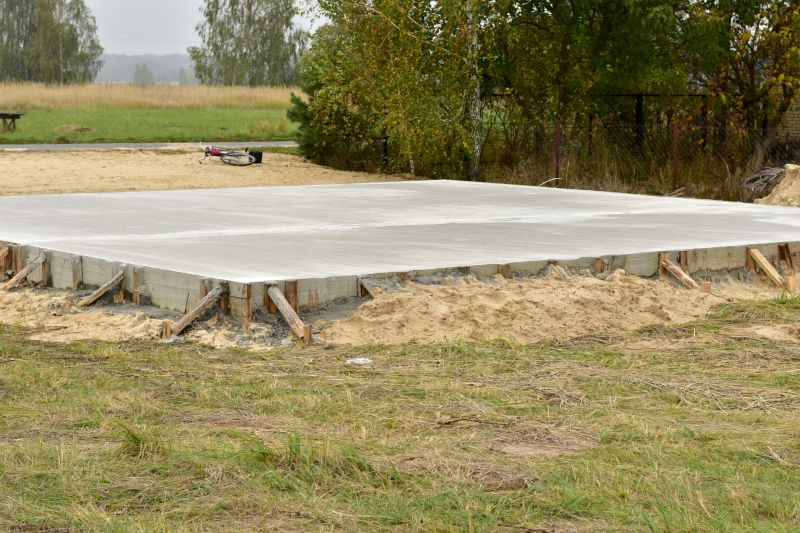Favorite Tools And Materials For Concrete Slab Installation Projects
A curated selection of top-rated products that make concrete slab installation straightforward and effective.
 Constructing a durable and level concrete slab requires careful selection of the right products. From foundational materials to finishing tools, each component plays a vital role in ensuring the stability and longevity of the slab. Proper preparation and quality materials can help prevent common issues such as cracking, uneven surfaces, and structural failure. Whether for residential driveways, commercial floors, or outdoor patios, understanding the available products and their functions can make the installation process more efficient and successful.
Constructing a durable and level concrete slab requires careful selection of the right products. From foundational materials to finishing tools, each component plays a vital role in ensuring the stability and longevity of the slab. Proper preparation and quality materials can help prevent common issues such as cracking, uneven surfaces, and structural failure. Whether for residential driveways, commercial floors, or outdoor patios, understanding the available products and their functions can make the installation process more efficient and successful.
Top Overall Option
Heavy-Duty Concrete Forming and Reinforcement System
A comprehensive forming and reinforcement system designed to provide stability and shape for concrete slabs. This versatile setup includes durable forms, rebar, and accessories that facilitate precise installation and help maintain structural integrity. Suitable for various project sizes, it offers a reliable foundation for achieving level and consistent surfaces.
Types of Products For Concrete Slab Installations
Concrete Form Boards
Flexible or rigid boards used to shape and contain poured concrete during setting, available in various materials like plywood or plastic.
Rebar and Steel Mesh
Reinforcement materials that add tensile strength to concrete slabs, preventing cracking and structural failure.
Concrete Mixes
Pre-mixed or custom-blended concrete formulations tailored for specific strength and setting time requirements.
Expansion Joints
Materials that allow for controlled expansion and contraction of concrete, reducing stress and cracking.
Curing Compounds
Products applied to freshly poured concrete to retain moisture and promote proper curing.
Surface Sealants
Protective coatings that seal the surface of the concrete, enhancing durability and appearance.
Leveling Compounds
Materials used to correct uneven surfaces before pouring or finishing concrete.
Vibrators and Tamps
Tools that help eliminate air pockets and ensure proper compaction of concrete during pouring.
Form Release Agents
Products that facilitate easy removal of forms after concrete has set, preventing sticking and damage.
Joint Fillers and Sealants
Materials used to fill and seal joints, preventing debris ingress and maintaining slab integrity.
Concrete Edgers and Groovers
Tools that create decorative or functional edges and control joints on the slab surface.
Concrete Finishing Tools
Tools such as trowels, floats, and brushes used to achieve smooth, textured, or decorative finishes.
Popular Choices
Enhanced concrete formulations that improve adhesion and flexibility, suitable for various applications.
Flexible joints that accommodate movement and reduce cracking risk, available in various sizes.
Widely used reinforcement material that provides tensile strength and crack control.
Sprayable or brushable products that help retain moisture during curing, promoting proper setting.
Products that delay surface hardening, enabling decorative finishing techniques.
Synthetic or steel fibers added to concrete to enhance crack resistance and durability.
Materials used to create a smooth, level surface before final flooring or overlay installation.
Pre-formed shapes that help create clean, defined edges on slabs and walkways.
Accessories that improve the efficiency of vibrators, ensuring proper compaction.
Tools that impart decorative or functional textures to the slab surface post-pour.
A typical concrete slab installation involves multiple stages, including site preparation, form setting, reinforcement, pouring, and finishing. Each stage requires specific products designed to meet the demands of the project. For example, reinforcement materials like rebar or wire mesh provide tensile strength, while curing compounds help maintain moisture levels during the curing process. Choosing the right combination of these products can influence the final outcome, ensuring the slab performs well over time.
In addition to structural components, there are various tools and accessories that facilitate a smoother installation process. These include leveling compounds, expansion joints, sealants, and surface treatment products. Selecting high-quality, compatible products can help achieve a uniform surface finish, reduce installation time, and improve the overall durability of the concrete slab. Properly coordinated products and materials are essential for both professional contractors and DIY enthusiasts aiming for a reliable and long-lasting result.
Key Buying Considerations
- Project scale and size to determine the quantity and type of materials needed.
- Compatibility of reinforcement materials with the concrete mix and project requirements.
- Weather conditions during installation, affecting curing times and product selection.
- Type of finish desired, influencing choice of surface treatment and finishing tools.
- Ease of use and handling, especially for DIY projects versus professional installations.
- Durability and load-bearing capacity required for the slab's intended use.
- Availability of accessories like expansion joints, sealants, and curing compounds.
- Budget constraints balanced with quality to ensure a reliable outcome.
- Compatibility of form materials with the concrete mix to prevent sticking or damage.
- Ease of removal and cleanup after the concrete has set.
- Environmental conditions such as moisture or temperature that may impact curing.
- Local building codes and standards that may specify certain materials or methods.
- Long-term maintenance requirements based on the products selected.
- Availability of technical support or guidance for complex installation processes.
- Product shelf life and storage considerations to prevent wastage.
This content may contain affiliate links. We may earn a commission if you purchase through these links, at no additional cost to you.
